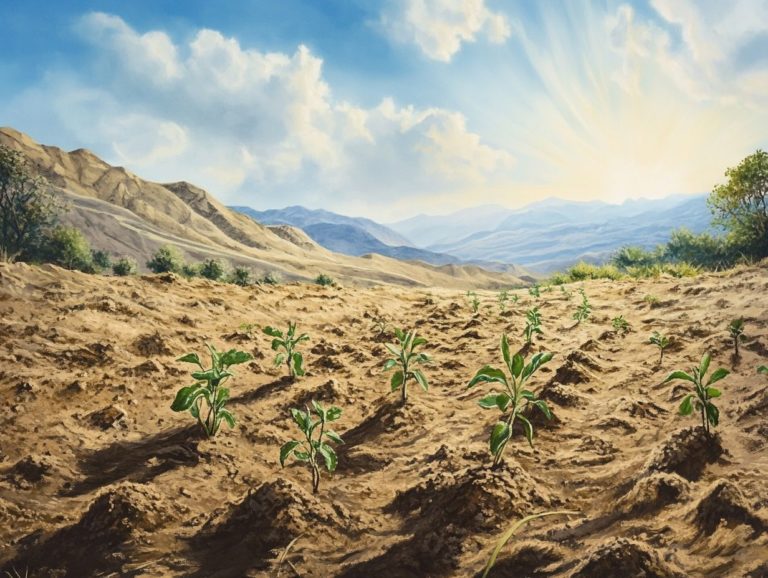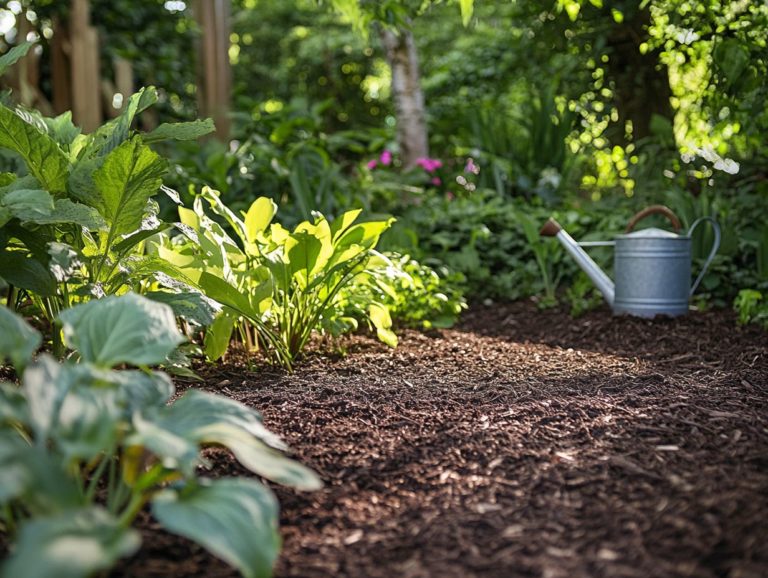How to Build Healthy Soil Using Cover Crops
Healthy soil serves as the cornerstone of flourishing gardens and sustainable ecosystems. This exploration delves into the crucial role that healthy soil plays for both plants and the environment, introducing you to cover crops as an invaluable tool for enhancing soil health.
You ll gain insights into the various types of cover crops, their benefits, effective planting strategies, and common pitfalls to avoid. This guide will navigate you through the journey of cultivating resilient soil that nurtures not only your garden but also the planet.
Discover the game-changing benefits of cover crops today! Learn how to seamlessly incorporate them into your gardening practices for a vibrant, thriving landscape.
Contents
- Key Takeaways on Healthy Soil:
- The Importance of Healthy Soil
- What are Cover Crops?
- How Cover Crops Improve Soil Health
- Pick the Perfect Cover Crops for Thriving Soil!
- Planting and Managing Cover Crops
- Incorporating Cover Crops into Crop Rotation
- Common Mistakes and How to Avoid Them
- Frequently Asked Questions
- What are cover crops and why are they important for building healthy soil?
- How do cover crops improve soil quality?
- Which cover crops are best for building healthy soil?
- How do I plant cover crops for optimal soil health?
- How often should cover crops be planted to maintain healthy soil?
- Can cover crops be used in all types of farming systems?
Key Takeaways on Healthy Soil:

- Cover crops are a natural and cost-effective way to improve soil health, resulting in healthier and more productive plants.
- Proper selection and management of cover crops can enhance the recycling of nutrients and overall soil structure, leading to increased water retention and decreased erosion.
- You can easily incorporate cover crops into crop rotations, providing benefits such as weed suppression and nitrogen fixation for subsequent crops.
The Importance of Healthy Soil
Healthy soil is vital for sustainable agriculture. It plays a pivotal role in enhancing environmental sustainability, fostering biodiversity, and supporting robust agricultural systems.
According to the USDA and NRCS, soil health encompasses more than just nutrient content; it includes factors like soil structure, organisms, and microbial activity that contribute to its overall vitality.
This intricate ecosystem serves as the foundation for crop production, influencing everything from soil moisture to nutrient recycling. When managed properly, healthy soil leads to better crop yields, promotes ecosystem health, and enhances resilience.
Benefits of Healthy Soil for Plants and the Environment
Healthy soil is a cornerstone for both your plants and the environment. It enhances plant diversity, improves nutrient management, and minimizes environmental impact.
This vibrant ecosystem serves as a solid foundation for various plant species, ensuring a balanced nutrient cycle while optimizing water retention. Well-structured soil allows roots to dive deep, fostering stronger, more resilient plants. Additionally, healthy soil addresses challenges like erosion and compaction, which can degrade land and diminish agricultural productivity.
Consider practices like cover cropping and crop rotation. These methods rejuvenate soil health and anchor the soil with plants, effectively combating erosion. By embracing these sustainable strategies, you contribute to a more robust ecosystem, promoting biodiversity and enriching the environment.
What are Cover Crops?
Cover crops are plants grown to protect and enrich soil, making them essential for healthy gardening. Varieties such as legumes and cereal rye are instrumental in sustainable farming practices, effectively preventing soil erosion, enhancing soil structure, and boosting organic matter content.
By keeping living roots in the soil, cover crops nurture soil organisms and microbial activity, cultivating a robust soil food web. Their incorporation into crop rotations improves nutrient recycling and enhances soil moisture retention, ultimately leading to healthier crops and greater ecosystem resilience.
Definition and Types of Cover Crops
Cover crops are your secret allies in the quest for improved soil health, erosion prevention, and enhanced agricultural systems. By incorporating a variety of species into your farming practices, you can tap into the unique benefits that each type brings.
For example, legumes like clover and vetch excel at fixing nitrogen in the soil, leading to natural nutrient enrichment. Meanwhile, cereal rye boasts an extensive root system that improves soil structure and prevents erosion.
Together, these cover crops work wonders, significantly boosting organic matter and fostering beneficial microbial activity, which enhances soil biodiversity. This synergy supports healthier crops and contributes to a more resilient agricultural ecosystem.
Start using cover crops today to transform your garden and the environment!
How Cover Crops Improve Soil Health

Cover crops play a transformative role in enhancing soil health. They employ various mechanisms that include boosting nutrient cycling, improving soil structure, and increasing organic matter content.
Integrating these crops into your farming practices is vital. It helps cultivate a vibrant and sustainable soil ecosystem.
Nutrient Cycling and Soil Structure
Nutrient cycling and soil structure are essential elements of soil health. Cover crops significantly enhance these aspects.
These plants, especially legumes, are instrumental in nitrogen fixation (the process of converting nitrogen into a usable form for plants). They enrich your soil with vital nutrients that promote robust plant growth.
When you integrate cover crops into your farming systems, you cultivate a diverse habitat for soil organisms think bacteria, fungi, and earthworms all of which actively contribute to breaking down organic matter.
This dynamic biological activity improves soil aeration and water retention. It also creates a healthier environment for your next crops.
Consequently, you can expect to see increased yields and greater resilience against pests and diseases. This ultimately paves the way for more sustainable agricultural practices.
Pick the Perfect Cover Crops for Thriving Soil!
Selecting the ideal cover crops for your garden is crucial for enhancing soil health and promoting successful plant growth. This process requires careful consideration of various factors tailored to your unique agricultural needs.
Factors to Consider and Popular Choices
When selecting cover crops, consider several key factors such as soil types, climate, and the specific benefits you wish to achieve for your garden.
Recognizing that different regions present a range of climates from arid landscapes to humid environments can dramatically impact the effectiveness of your selected cover crops.
For example, if your garden is in the Midwest, you might find that winter rye thrives beautifully, given its resilience in colder temperatures.
Conversely, if you re gardening in the South, buckwheat may be your go-to, flourishing in the warmth.
Soil conditions are equally crucial. For clay-rich soils, crops like hairy vetch can enhance aeration, while sandy soils may yield better outcomes with legumes like clover.
Popular choices such as crimson clover, celebrated for its nitrogen-fixing abilities, and daikon radish, which effectively breaks up compacted soil layers, cater to various gardening objectives from boosting fertility to enhancing overall soil structure.
Planting and Managing Cover Crops
Planting and managing cover crops effectively unlocks their incredible benefits for soil health. This approach ensures your crop rotations are successful and fruitful!
Best Practices for Successful Growth

Implementing best practices for the successful growth of cover crops is crucial. This ensures they effectively enhance soil moisture retention and nutrient management.
By incorporating techniques like soil testing, you can gain valuable insights into the specific nutrient needs of your fields. This allows for more targeted fertilization strategies.
Maintaining the right seeding rates is equally important; it prevents overcrowding and enables each plant to thrive, maximizing its benefits for the soil.
Effective pest management practices, including crop rotation and integrated pest management, help you mitigate potential threats to your cover crops. This preserves their health and vigor.
Collectively, these practices not only bolster the resilience of cover crops but also promote improved soil health. This contributes to a more sustainable agricultural ecosystem overall.
Incorporating Cover Crops into Crop Rotation
Incorporating cover crops into your crop rotation is a remarkably effective strategy. It fosters soil health and enhances agricultural productivity.
By doing so, you create a more sustainable farming system that benefits both the land and your yields.
Start integrating cover crops today to boost your soil health!
Benefits and Strategies for Crop Rotation with Cover Crops
The benefits of crop rotation with cover crops are abundant, offering you enhanced soil health, improved nutrient availability, and reduced soil erosion.
By adopting these practices, you can cultivate a diverse array of plants that significantly boost microbial activity in the soil. This leads to more effective nutrient cycling. For instance, interspersing legumes with grains not only fixes nitrogen but also enhances soil structure.
Incorporating deep-rooted cover crops like radishes breaks up compacted layers, improving moisture retention and drainage.
Successful implementations, such as using winter rye in corn-soybean rotations, demonstrate remarkable improvements in both yield resilience and soil organic matter. This shows how strategic crop choices can lead to a more sustainable farming system.
Common Mistakes and How to Avoid Them
Understanding common mistakes in cover crop management is essential for unlocking their full potential in enhancing soil health and optimizing planting effectiveness. By being mindful of these pitfalls, you can ensure that your cover crops thrive and contribute significantly to your agricultural success.
Troubleshooting Tips for Cover Crops
Troubleshooting tips for cover crops can be your secret weapon in tackling common planting challenges that influence soil moisture and nutrient cycling!
Effectively managing these crops is crucial for maintaining soil health and advancing agricultural sustainability. If you notice low germination rates, it might be time to adjust your planting depths or ensure that soil temperature and moisture conditions are suitable for optimal seed establishment.
Stay vigilant about pests, as certain cover crops can attract unwanted critters that harm your crops. Employ methods to control pests without harming crops to mitigate these risks.
Addressing nutrient deficiencies by incorporating organic amendments or selecting the right cover crop species creates a more fertile environment. This enhances the resilience and productivity of your entire farming system.
Frequently Asked Questions

What are cover crops and why are they important for building healthy soil?
Cover crops are plants that are grown specifically to improve the quality and fertility of soil. They are important because they:
- Prevent erosion
- Add nutrients to the soil
- Improve soil structure
- Suppress weeds
How do cover crops improve soil quality?
Cover crops improve soil quality by:
- Adding organic matter
- Increasing microbial activity
- Promoting water retention
- Breaking up compacted soil for better root growth and nutrient absorption
Which cover crops are best for building healthy soil?
The best cover crops for building healthy soil depend on your specific soil type and climate. Commonly used cover crops include:
- Legumes like clover, vetch, and beans
- Grasses like rye, oats, and millet
How do I plant cover crops for optimal soil health?
To plant cover crops for optimal soil health, consider:
- Timing
- Seeding rates
- Soil preparation
Cover crops should be planted at the right time of year, with the right amount of seeds per area, in soil that has been properly tilled and prepared.
How often should cover crops be planted to maintain healthy soil?
Cover crops should be planted at least once a year to maintain healthy soil. However, it can be beneficial to plant them multiple times throughout the year, especially in areas with harsh weather conditions or high levels of soil depletion.
Can cover crops be used in all types of farming systems?
Yes, cover crops can be used in all types of farming systems, including:
- Conventional
- Organic
- No-till farming
They can also be used in both large-scale and small-scale operations to improve soil health and increase crop yields.
Start planning your cover crop strategy today for better soil health!






